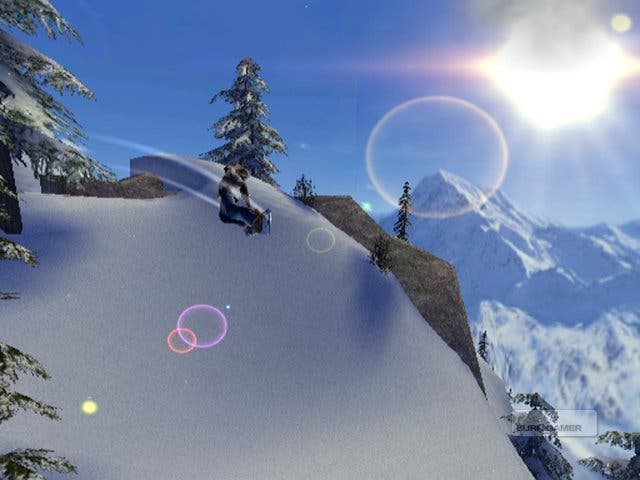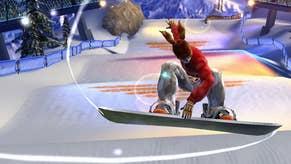Retrospective: SSX 3
Flying solo.
And, counterintuitively, SSX 3's brilliant audio design is at its best when the music fades away. When you launch off a particularly steep vertical, the soundtrack mutes almost entirely. It's like the game is holding its breath right along with you. The sliders on SSX 3's virtual mixing board also go down when you ride into the peak's more secluded areas, leaving just a low beat, as if the thick powder is muffling the tunes. Is it possible to recreate the sound of snow? This game comes pretty close.
That realism was something of a departure for the series, as the aesthetic in SSX Tricky was less "alpine majesty" than "giant pinball machine". But nobody would mistake SSX 3 for a true-to-life simulator. For one thing, the steep curves and vertigo-inducing cliffs of the SSX 3 mountain are still far beyond anything a sane boarder would attempt to traverse.

More to the point, riders in SSX 3 still ply their trade with tricks that defy the limits of comprehension, the human body, or the laws of physics. Obviously, no real-world snowboarder has ever executed a Frontside 1080 Double Backflip Trickitello to Late Nifty Shifty - I doubt any real-world snowboarder even knows what it means. I certainly don't, but who cares? What matters is that it's a contorted, gyrating work of aerial art in motion, and after a few hours to get the feel of the game's trick system, even a novice can pull one off.
The more grounded context of SSX 3 makes the mid-air stunts all the more thrilling. Sure, in SSX Tricky you could do some nutty tricks. (Perhaps you deduced that from the title.) It was all of a piece with the over-the-top setting, though. When giant air vents catapult you onto loopy, Dr. Seuss-ian metal ramp, your spectacular twists and board grabs seem like par for the course. Spinning like a top upside-down in the SSX 3 backwoods is a more startling, compelling image. Because the surroundings are more real, the tricks feel more unreal.

Best of all, there's nobody around to see it. SSX 3 has been on my mind because I recently played and reviewed Skate 3, another EA counterpoint to the Tony Hawk series. In Skate 3, you're rarely alone. Whether it's your cameraman, adoring crowds in the bleachers, or even random passersby, there's almost always someone on hand to tell you what sick moves you're laying down. The game encourages real-world extroversion, too. Post your best photo! Email your friends a link to your video! Build the ultimate skate park for the world to see!
Conversely, when you land a killer trick in SSX 3, your character typically applauds him or herself, and that's the end of it. You were there to witness your own triumph; move on.
I'm not going to pretend that everything was better back in the day. Skate 3's community features are undeniably cool. There has been something lost, though - a sense of contented loneliness has been sullied by a unspoken mandate to join the masses. When I ride down the frigid slopes of SSX 3, I experience moments of glory that are communicated solely between the mountain and me, and I fondly recall an era when that was enough.









